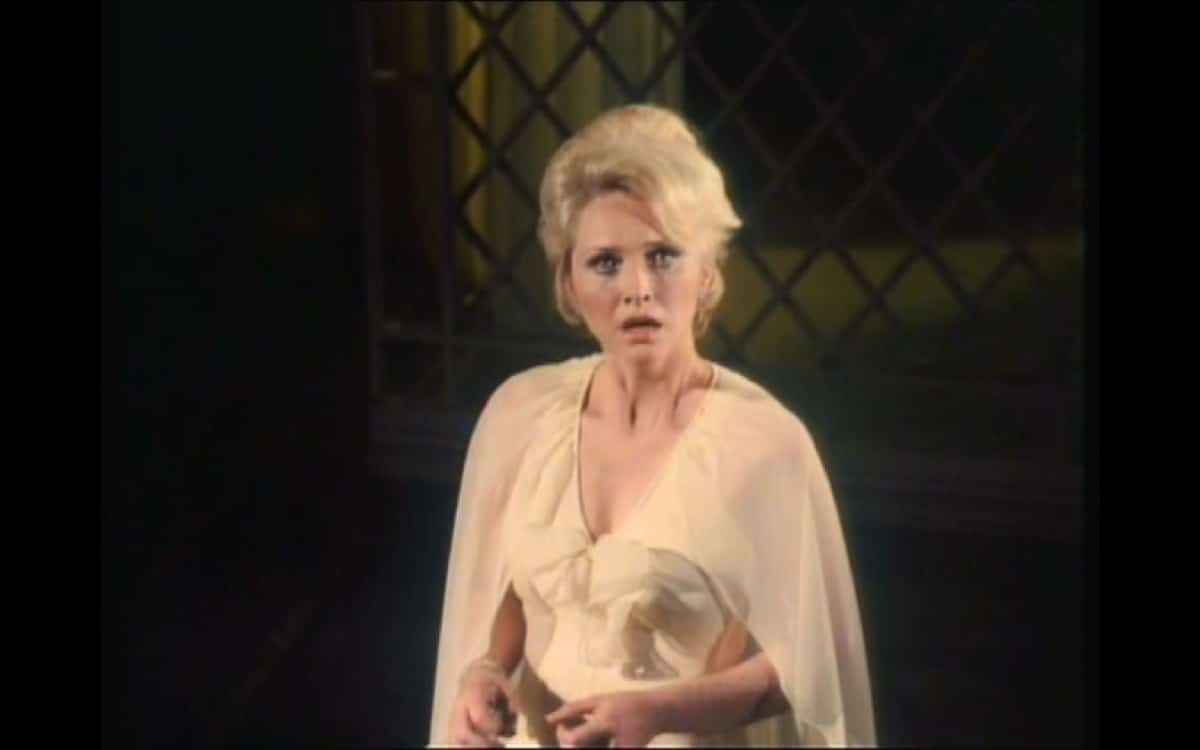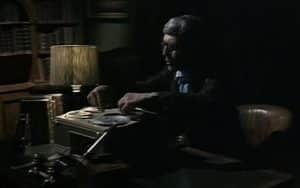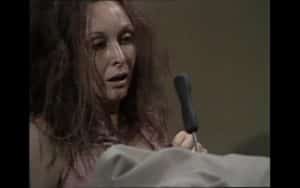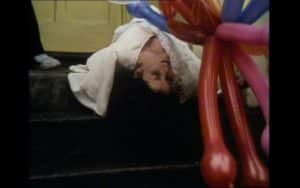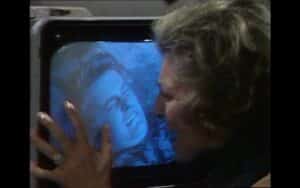An opera singer’s plans for the future are disrupted when a face from the past reappears. RICHARD PHILLIPS-JONES looks at Nightmare For A Nightingale.

TITLE: Thriller – Nightmare For A Nightingale
BROADCAST: 24 April 1976
STARRING: Susan Flannery, Keith Baxter, Sydney Tafler, Ronald Leigh-Hunt, Stuart Damon, Gita Denise
WRITER: Brian Clemens
DIRECTOR: John Scholz-Conway
Tony Risanti (Baxter) is a man with much on his mind, a talented and apparently successful opera singer who nevertheless finds himself in the shadow of his wife, uber-talented soprano Anna Cartell (Flannery) and deep in debt (through gambling) to the wrong kind of people. He sees his chance of escape in the form of a homeless feller he has taken in off the streets, plying him with drink while he readies himself to kill the unfortunate feller, dress the body in his own clothes and dump the corpse into the ocean, thus faking his own death.
Tony unloads his woes on his victim-to-be in an unusually long and verbose pre-credits sequence (it may well be the longest in Thriller’s run), but once the episode proper finally gets underway we leap forward some years to London’s Royal Opera House, where Anna is about to leave the stage after a triumphant performance.
Her manager Sam (Tafler) and tour manager Giles (Leigh-Hunt) are delighted with the rapturous audience reception afforded their client, as is personal assistant Maria (Denise). The star herself soon joins them, but any post-show celebrations are interrupted by the arrival of Hal Bridie (Damon), a rising politician and potential future presidential candidate who intends to marry Anna and thus prompts her announcement that she intends to retire from performing, a revelation which clearly has Sam and Giles immediately fearing for the future of their livelihoods.
And don’t these people love to talk! So much so that most of the first act feels like a prolonged exercise in verbal exposition, so bogged down in chat that the best the episode can manage as an end-of-part-one cliff-hanger is the revelation that Anna is going to look at a new house, a line that barely deserves the dramatic entry of Laurie Johnson’s commercial break music.
Never in the history of Thriller has my thumb hovered over the fast-forward button with such intent, I’m slightly ashamed to say but it’s a good thing I resisted the temptation as the second act improves matters considerably, as Anna heads to the aforementioned dwelling and is investigating the basement, when who should walk in but the missing-presumed-dead Tony.
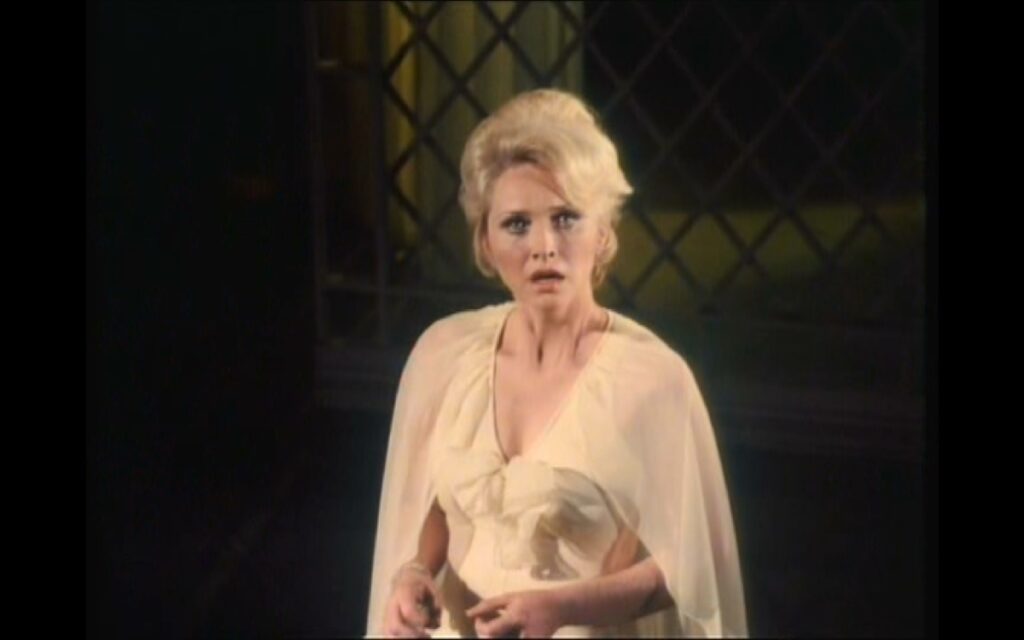
It’s a fantastic moment, superbly handled by director John Scholz-Conway which takes us back to top-notch Thriller territory, only let down by yet more yakking as Tony re-explains his faked death for Anna’s benefit. Still, the scene soon redeems itself when Anna learns that Tony’s intentions are less than honourable and are aimed at extracting a vast sum of money from her new beau’s fortune to keep his silence.
Knowing Tony’s untrustworthiness of old, Anna doesn’t believe that one payment will be enough for him and when she refuses, a struggle ensues, with Anna pushing Tony to the hard, concrete floor. With her back turned, Anna reconsiders but it’s only when she turns around that she sees Tony’s head has hit the ground and that he appears to be dead.
Moving Tony’s body to a cupboard while she considers her next move, Anna struggles to continue with business as usual and keep her composure in front of her team and her fiancé. However, when she goes on stage that night, she thinks she sees Tony watching from a private balcony…
Susan Flannery’s turn as Anna carries much of the episode towards its conclusion, with her increasing questioning of her own sanity and a crumbling ability to keep up a show of normality to both her audience and those close to her as she tries to figure out what’s really going on, which she finally does in a somewhat muted conclusion which was becoming something of a house-style for Thriller’s last episodes.
There are some nice touches of The Phantom Of The Opera in Tony’s cryptic deliveries of his trademark red carnations to the beleaguered singer’s dressing room, as well as in the performance scenes, with location work impressively mounted both inside and outside the genuine Royal Opera House with visual touches (such as some foreboding shadows looming on a bill poster) which evoke the expressionist stylings of vintage Universal horror and linger in the memory after viewing.
This is one Thriller story which perhaps suffers from the need to fill the show’s unusual runtime (a more traditional 1-hour TV slot might have done it the world of good), but Nightmare For A Nightingale is still an enjoyable entry in Thriller’s final series, once the viewer can get past its more loquacious tendencies.
TRIVIA NOTES: Retitled for its later TV-Movie version as Melody Of Hate. The change is understandable to an extent as one can imagine continuity announcers tripping over the original title – even the ATV production assistant speaking on the opening VT clock mispronounces it as “Night-ing-mare For A Nightingale”.
Stuart Damon, of course had previous form for ATV/ITC, having guested in many of their key shows of the late-60’s/early-70’s and taken a lead part in The Champions (1968-69).
Tony’s beloved red carnations jog a memory of Norman Eshley’s preferred flowers in series one’s classic, The Colour Of Blood.
SPOILER ALERT!: I suppose it shouldn’t ultimately have been a surprise that Sydney Tafler’s character was up to something, since he was best known to British viewers for playing gangster and spiv roles in such films as It Always Rains On Sunday (1947) and London Belongs To Me (1948), a persona he happily sent up as Sid James’ dodgy mate in Citizen James (1960-62). However, by the 1970’s he was getting more varied roles including a spell as the superior of Dutch policeman Van Der Valk (in its second series, 1973) and as a captain in The Spy Who Loved Me (1977). Sadly, Tafler’s life was taken by cancer in 1979, at the age of 63.

